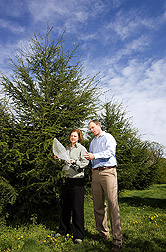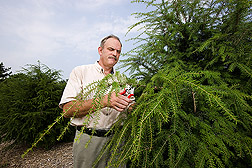Saving America’s Hemlocks
|
|
Hemlocks are popular, graceful trees well known to gardeners and landscapers. Unlike the poisonous herb made famous by Shakespeare and Socrates that goes by the same name, hemlocks are nonpoisonous, shade-tolerant, evergreen trees widely planted in backyards, landscapes, and gardens.
Tsuga canadensis, commonly known as the “eastern hemlock” and nicknamed the “Queen of Conifers,” and Tsuga caroliniana, commonly known as the “Carolina hemlock,” are the most commonly encountered hemlocks in the eastern United States. The eastern hemlock grows naturally in the Appalachian Mountains and as far west as Minnesota, while the Carolina hemlock is restricted to the Blue Ridge Mountains in the Carolinas and Virginia. Both play an important role in their native habitats, helping to form stable communities integral to the health of Appalachian forests.
Until recently, hemlocks have been very popular for landscape planting. But over the last few decades, the eastern and Carolina hemlocks have been under attack by a small sucking insect called the hemlock woolly adelgid (Adelges tsugae), or HWA. The insect, which is related to aphids, was accidently introduced from Asia and first observed in Virginia in 1951. It has since spread to forests and backyards in 17 eastern states, killing hemlock trees and devastating natural ecosystems.
“The hemlock trees are the HWA’s food source,” explains ARS plant geneticist Richard Olsen. “The insect virtually sucks the life out of the tree as it feeds. Unfortunately, our hemlocks in North America aren’t resistant to HWA, and no natural enemies of HWA exist here, so we often see a tree killed within just a few years of being infested.”
Faced with the extinction of our native hemlocks, the U.S. National Arboretum began a breeding program in the 1990s to determine the potential for crossing native hemlocks with those thought to be resistant to HWA. The work began under the direction of ARS plant geneticist Denny Townsend (now retired) and ARS horticulturist Susan Bentz. Olsen now oversees the breeding program since Townsend’s retirement.
|
|
Searching for More Resistant Genetic Material
In its native range of Asia, the HWA causes little damage to the hemlock trees it feeds on. This is because hemlocks in that area have evolved with the insect, developing resistance to its attacks. North American hemlocks evolved independently from HWA, which explains their lack of resistance.
At the beginning of the breeding project, ARS scientists obtained exotic species of hemlock from gardens throughout the country. But only two or three hemlock trees from China were available. While these trees were used to produce tolerant hybrids, the scientists needed a more diverse representation of resistant germplasm to optimize long-term success of the hybridization program.
In the early 1990s, ARS and public gardens throughout North America joined forces to create the North American China Plant Exploration Consortium. Together, these institutions made several collecting expeditions to Asia to find resistant hemlocks. The scientists mainly focused their efforts on collecting material from China, searching forests throughout the country. Each institution in the consortium brought back accessions for their respective collections.
“At the end of the expeditions, ARS brought back accessions of three Tsuga species: T. chinensis, T. dumosa, and T. forrestii,” says ARS horticulturist Kevin Conrad, who co-led the first expedition in 1996 to collect seeds of these hemlocks. “During one of these expeditions, we also found a species related to hemlock called ‘Nothotsuga longibracteata.’ This is a novel conifer species gardeners might be interested in.”
The ARS accessions are housed in the Woody Landscape Plant Germplasm Repository, which Conrad manages. There, Conrad and his colleagues maintain living plants in the field to provide seed and cuttings for scientific studies. Because hemlock seed have a short storage life, scientists must regularly replenish seed to maintain stock.
The hemlock accessions are just a few of the more than 1,400 accessions maintained in the genebank. Conrad and his staff also maintain more than 2,800 plants at field sites in Beltsville, Maryland, and Washington, D.C. While not all accessions in the collection are available for distribution, many of them are used in research projects by scientists all over the world.
New Hybrids Show Promise
At a field site in Beltsville, Maryland, rows of native, Asian, and hybrid hemlocks bask in the sun, each possessing a varying degree of tolerance to HWA. Curiously, the scientists could produce hybrids of Carolina hemlock but not of eastern hemlock. Carolina hemlock is a relic species, surviving in a small area and, surprisingly, is more closely related to the Asian hemlock species than to eastern hemlock. The threatened extinction of natural stands of Carolina hemlock by HWA and its genetic compatibility with its overseas cousins underscores the importance of germplasm preservation.
Since the start of the breeding program, the scientists have developed 140 Tsuga hybrids, 108 of which are suitable for testing. In 2006, Olsen and Bentz, along with USDA Forest Service entomologist Michael Montgomery, began a multiyear field trial to test each hybrid’s degree of tolerance to HWA. They artificially infested the hybrids by attaching bundles of HWA-infested branches to the hybrids’ lower branches and secured them to the trees with mesh bags to prevent the insects from escaping. The scientists tested more than 170 trees over the course of the trial.
“We found T. chinensis and its hybrids to be the most tolerant to HWA,” says Olsen. “Two types of resistance were observed: fewer adelgids settling on the trees, called ‘antixenosis,’ and slower growth and lower survival of the settled adelgids, called ‘antibiosis.’”
Olsen explains that the current hybrids are very appealing, not only due to their tolerance to HWA, but also because of their good vigor and shape. Even so, the scientists still have several years of testing to complete before they can release them to the public.
Olsen is preparing to send out the hybrids for long-term evaluation at several research sites in the eastern United States. He and Bentz are also completing their second 2-year study evaluating the hybrids’ HWA tolerance, this time in container-grown trees. They will continue their breeding efforts, hopefully finding a way to incorporate the aesthetic traits of eastern hemlock and the HWA resistance of exotic hemlocks into successful hybrids.
Thanks to scientists at the U.S. National Arboretum, we’re one step closer to seeing hemlock trees that can stand up to this pesky pest.—By Stephanie Yao, Agricultural Research Service Information Staff.
This research is part of Plant Genetic Resources, Genomics, and Genetic Improvement (#301), an ARS national program described at www.nps.ars.usda.gov.
To reach scientists mentioned in this article, contact Stephanie Yao, USDA-ARS Information Staff, 5601 Sunnyside Ave., Beltsville, MD 20705-5129; (301) 504-1619.
"Saving America’s Hemlocks" was published in the November/December 2010 issue of Agricultural Research magazine.








